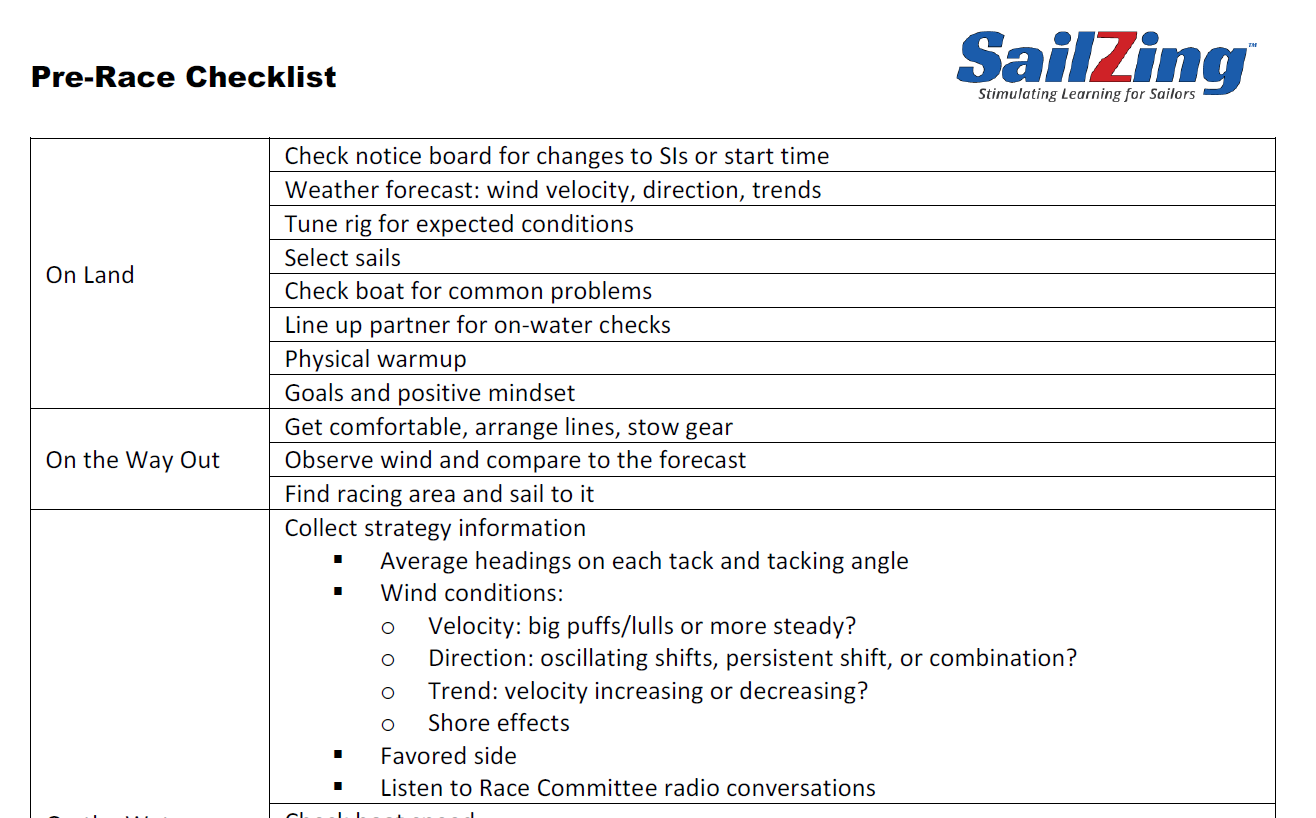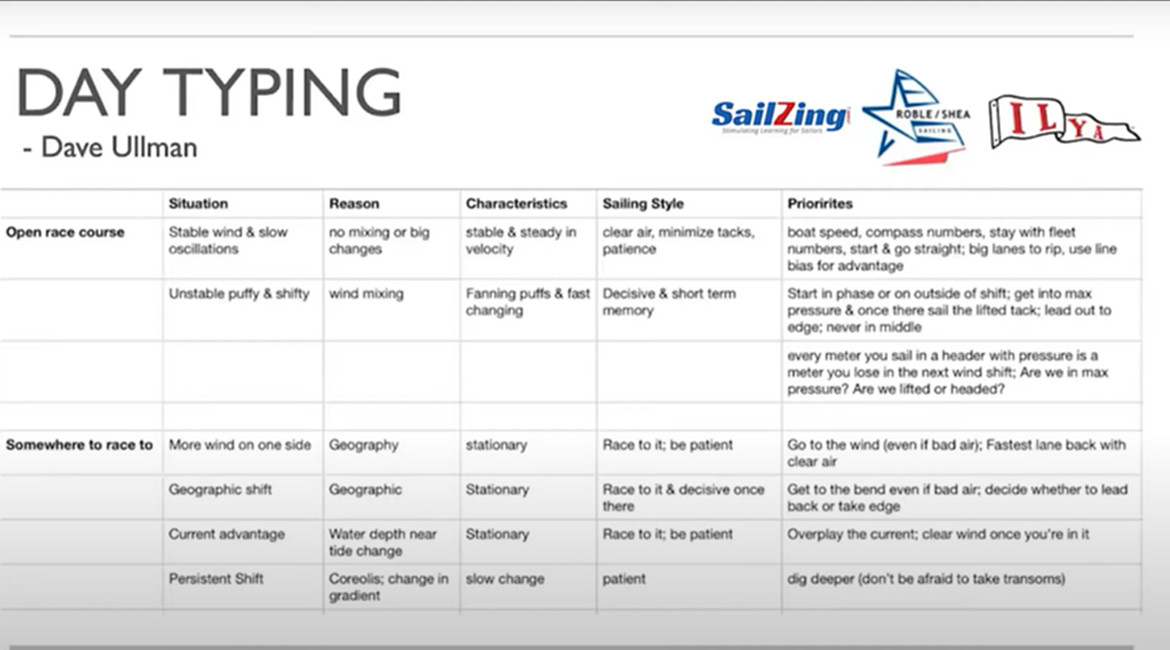Every battle is won before it is fought.
Sun Tzu, Chinese general, military strategist, writer, and philosopher
The above quote could well apply to sailboat racing and your pre-race routine. Success in racing is based many factors – better mental and physical preparation, equipment, better decisions, perfect execution. A solid pre-race routine can give you a leg up on many of these factors.
Out on the water, you can see how the serious competitors spend their time before the race. They’re not reaching back and forth behind the line or sailing around in a relaxed manner. Many of them use a similar focused approach even before going out on the water.
We compiled a list of things to consider for a pre-race routine, using all available sources. We were surprised at its length. You may not be able to do all of these items, but if you develop a routine and concentrate, you can do plenty without tiring yourself out.
Here’s our list of items to consider, with some explanations and links to further reading. See the link below for a printable PDF checklist.
We’ve updated this post from the original, adding a video on pre-race routine from Roble/Shea Sailing and more insights from top sailors.
Video: Pre-Race Routine – Roble / Shea Sailing
Pre-Race Routine – Expert Advice Compiled
On Land
Get your mind, body, and boat ready to race before going out on the water.
- Check the notice board for any changes to SIs or start time. Don’t be caught unaware of some important change.
- Know the weather forecast, including wind velocity, direction, and trends, as well as temperature and precipitation for comfort.
- Hydrate gradually through the morning.
- Tune your rig for expected conditions.
- Select your sails. Buddy Melges (Sailing Smart) says to wait as long as possible before deciding, and then pick the sails that will be most effective for the wind on the first leg.
- Check your boat for common problems: water accumulation, breakdown items.
- Line up a partner if you want to do favored side and speed checks on the water.
- Warm up your body, using dynamic stretches. A sluggish body means sluggish sailing. See our post on stretching for more.
- Focus your mind on your goals and getting the right positive mindset.
On the Way Out
Most top sailors recommend hitting the water 45-60 minutes before the scheduled start. In big breeze, shorten this time to remain fresh. If the course is a long way out, hit the water earlier.
- Get comfortable in the boat. Arrange your lines, adjust your hiking straps, make sure your gear is stowed properly.
- Start observing the wind and compare to the forecast.
- Find the racing area and sail to it before practicing.
In the Racing Area
Collect Strategy Information
- Determine the wind conditions. These are crucial inputs to your strategy.
- Velocity: big puffs/lulls or more steady?
- Direction: oscillating shifts, persistent shift, or combination?
- Favored side due to more wind, shore effects, or favorable shifts?
- See Roble/Shea’s video on Upwind Strategy at 00:26:33 for a discussion of “day typing” based on wind conditions.
- Sail upwind for as much of the beat as possible. Even better, sail on both sides of course for at least part of the beat. You can do this on your own or with a partner. Here’s a good article from Sailing World on using a partner.
- For a a different and more time-efficient approach, stay in the starting area and observe other boats sailing the beat, instead of sailing it yourself. See our post on Pre-Race Routine – Observe Other Boats for more.
- Get average headings (compass or visual) on each tack. This is crucial for determining whether you are on the lifted tack during the race.
- Check headings at top and bottom of course to see if there is a wind bend.
- Make sure you know your tacking angle for the conditions.
- If available, listen to Race Committee radio conversations about wind direction and compare to your observations.
Check Boat Speed
- Spend time tweaking your sail controls to get fast in the conditions.
- If available, line up and check speed with a partner.
- In puffy conditions, tune up your transitions.
- Check the wave set on each tack. Figure out how to go fast in each wave set.
Warmup – Boat Handling
Some sailors advocate getting the juices flowing by doing tacks and gybes and maybe even some penalty turns.
Develop a Preliminary Strategy for the First Beat
Based on the information you collected, develop a strategy. See our posts on Upwind Strategy and Tactics for more.
Fuel Up and Relax
As you sail back down to the starting area, use some time to get your body and mind relaxed and ready to race.
- Hydrate, snack
- Add or remove clothing layers as needed
- Relax, breathe
- Low pressure conversation with crew
10-15 Minutes Before Start
Check the Wind – Often
- Keep looking upwind to see if one side looks favored.
- Observe other boats carefully.
- This might be a good time to sail upwind from the line with a buddy on the opposite tack, and then see who crosses ahead when you come back.
- Continue checking the average heading on each tack.
Practice Starts/Acceleration
- Tune up your acceleration technique and sense of time and distance with a few timed practice starts. Don’t wait until the start to do this.
- Use a buoy or the gate if the starting line is not set.
- Roble/Shea point out that it’s rare to have your best acceleration the first time you try it.
- Terry Hutchinson often devotes ten minutes to thi sin pre-start period.
Check Your Boat
- Take another look at the most critical breakdown areas.
Check the Course
- Make sure you understand the posted course and the bearing to the first mark. The bearing to the first mark tells you what the RC thinks is the average wind direction. Compare this to your own observation.
- Locate the windward mark visually.
- Check the gate for bias if it is in place.
Update 1st Leg Strategy
- Based on recent observations, determine if your preliminary strategy is still valid.
- Talk this over with your crew.
Check the Line
- Line set: square to the average wind or skewed? This is one input in deciding where to start. If there is a mid-line boat, check both halves of the line. Remember, you are checking the line set against the wind direction, not the mark placement. See our post on ladder rungs for more on this.
- Get a line sight. You may not always be able to use it, but it can be extremely valuable. See our post on line sights for more.
- Sail the laylines to ends of the starting line, especially if you plan to start at an end.
- Determine how long it takes to sail up and down line, in case you need to change your chosen location late in the sequence.
Starting Sequence
5 minutes
- Be at the signal boat to check course, headings, and synchronize your timer.
- Compare the wind direction to the line set again. Greg Fisher recommends checking at least ten times during the sequence.
- Stay at the line or in front of the line and keep looking upwind for clues. Look way up the lake. At this point in the sequence, wind conditions half way up the course will no longer be relevant at the start. Use flags, water, trees, and other fleets. See this Sailing World article about using other fleets for clues.
- Check your line sight again.
- Clear your foils of weeds.
4 minutes
- Check the prep flag and timing.
- Check wind direction compared to the line set again.
3 minutes
- Check the wind direction compared to the line set again.
- Look up the weather leg to find the next puff or shift. Keep checking this until 2 minutes remaining.
- Review and adjust your preliminary strategy based on observations.
2 minutes
- Determine your game plan and sail to the side you want to start. See our post on where to start for more.
1 minute
- From here on, your full focus is to get a hole to leeward, manage time and distance, and be in the front row with speed at the gun.
- Set up in your chosen area of the line, considering traffic.
- Use your “below the line” sight for initial distance from the line.
- Final call on need for bailout if position is bad. (This could be as late as 30-45 seconds if wind allows.)
30 seconds
- Where is your bow compared to other boats (behind, ahead, even)?
- Get a gap to leeward and defend against last minute poachers.
20 seconds
- Set your sail controls and foils for the wind conditions. Err on the side of slightly more power, since the wind is slightly diminished at the line (snow fence effect) and you need to accelerate.
- Manage your speed and flow over the foils based on time and distance.
15 seconds
- Pre-load your sail trim.
- Determine when to make your final acceleration. Use your line sight and time/distance awareness.
- Match the boats around you if getting buried.
Pre-Race Routine Checklist
Click here for a printable PDF checklist version of this article.
Related Content:
Terry’s Tips: Warm Up Right – Sailing World
Tactics with Mike: Sail1Design Pre-Start Routine
Racing Tactics – by Greg Fisher (This is an older video from Greg. The first 20 minutes covers the pre-race routine.)
Sailors Helping Sailors
Will you share your knowledge with your related Comments below?



